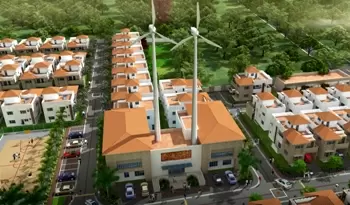Going green is just about making smart choices

09-June-2012
Vol 3 | Issue 23
Environmental consciousness is catching up to business consciousness thanks to various efforts like green building ratings and extensive dialogue on global warming caused by widespread increase in green house gas emissions.
What exactly does a green building mean, and how does a green economy function? According to David Puttnam, Chairman of the Trustees in the Forum for the Future, “Vibrant local economies, new jobs, high quality housing (with solar roofing), integrated transport, regeneration that makes a real and lasting difference.
Unbelievable that some people still think that sustainable development is about the birds, bees and trees!”
 |
|
Graphic representation of a green township (Courtesy: Isha Homes)
|
How do we get to the point where we are cognizant of our environmental footprint? Some of the basic principles of living green include reduce, reuse and recycle; choosing materials with low embodied energy and understanding the life cycle of a product, without compromising on the quality of life that makes human life a pleasure.
Buildings and the built environment have the largest impact on the ecological symbiosis, or rather the lack of it. Therefore, the biggest impact we can make on reducing our carbon footprint is in the choices we make within the built environment.
Reduce, reuse and recycle
Reducing consumption is the best way to reduce the demand for energy, and thereby reducing carbon output. Reusing and recycling already processed materials will also aid in the same.
Buildings with adequate day lighting, ample natural ventilation and located within already developed connectivity network are the best examples of this principle. Additionally, use of energy saving appliances and fixtures and using recycled/ refurbished materials or materials with recycled content will also help in making a larger impact.
Embodied energy
Any material that is processed requires energy to be converted from its raw form to its final form. The amount of energy that is spent in this process is called embodied energy. Needless to say, the materials with low embodied energy have the least impact on the environment.
Normally, materials that require a large amount of energy to be processed and cannot be reused have a larger embodied energy than materials that take the same amount of energy to be processed but can be reused or recycled. A building that is green not only chooses materials that have low embodied energy, but also uses less energy than a normal building for its everyday functioning.
Cradle-to-grave
All materials go through a cycle of being produced from raw materials to being utilized to being cast away as waste. The life of materials being cast away is generally oblivious to most civilization, and these cause the most lasting environmental damage. By reducing waste or recycling waste or by using materials that can be disposed of in environmentally friendly ways, impact on the environment can be minimized.
Quality of life
Apart from clean air for breathing, clean water and a healthy environment, a sustainable lifestyle is also about a healthy quality of life. Going Green is not about making sacrifices and going back to living in the stone ages. It is about making smart choices.
If you had to travel one hour or sit in traffic congestion for hours together to get to the place of your choice every time, which unfortunately is the way Indian cities are hitherto developing, the spontaneity of life is lost. The ability to make spontaneous choices is the essence of quality human life and any development should be cognizant of this factor as the most significant one in ‘Living Green’.
Who is responsible?
The responsibility of steering the earth back towards ecological symbiosis rests with each one of us. If all of us made conscious choices, it would go a long way in protecting the resources of this planet and also enable us to live a healthy life for generations to come.
Some of the choices everyone can make include choosing public transport over private cars or two wheelers wherever possible, supporting businesses that are environmentally conscious, reduce wastage in our day-to-day lives and being compassionate with our fellow human beings while sharing our space with them.
Architects and builders for their part would need to build more sociable environments that enables healthy and spontaneous face-to-face interactions, the kind of which human society is built upon.
Policy makers and regulators need to shun the private automobile and steer development towards emancipation of human life.
To quote Enrique Penalosa, former mayor of Bogota, private automobiles are private problems that need to be sorted out with private money, public money should be spent for the greater good.
With this principle as its guiding force, Bogota went from being a crime ridden shanty town to a bustling 21st century city. In the story of Bogota lies our inspiration to turn things around and getting back to living the humane way.
Aparajithan Narasimhan is Assistant Professor, Rajalakshmi School of Architecture, Chennai
















